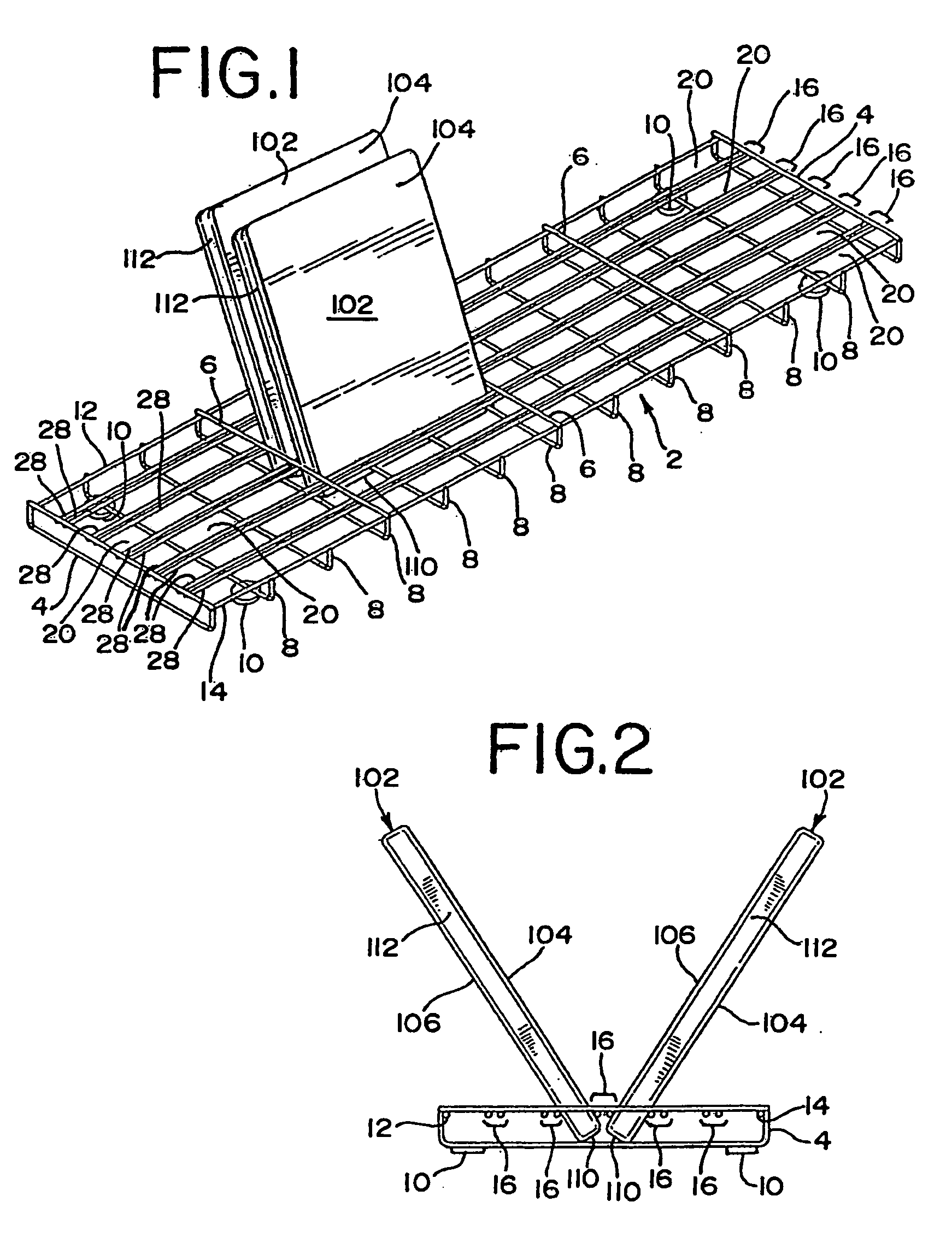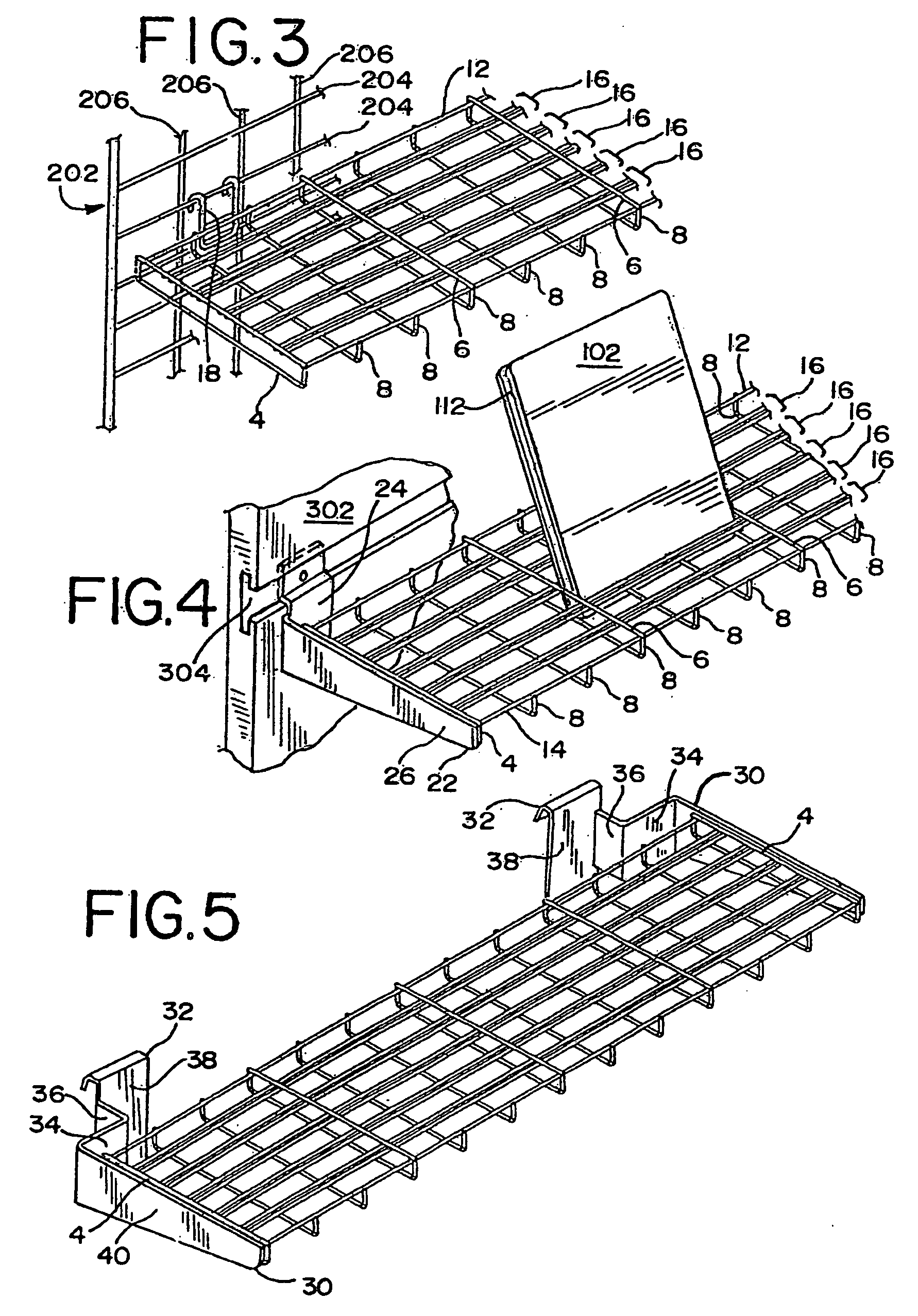Retail stores, including especially video rental stores (hereinafter collectively referred to as “video stores”), experience problems effectively, attractively, and economically displaying the wide variety of
multimedia systems, such as DVDs, CDs, and
video game discs, currently offered to the public.
Shelving of DVD cases in their packages in a manner so as to make the cases accessible to the public and easily maintained on the shelves by proprietors of video stores is a constant problem.
One problem faced by video store proprietors is that, in order to increase revenues and to decrease unproductive backstock, proprietors often desire to increase the number of DVD cases that can be stacked on shelves in the video store establishment so that they can be viewed and purchased (or rented) by consumers.
The video stores, however, have only a limited number of linear feet of shelf space in the establishment.
On the other hand, many shelving systems that are used for increasing the number of units of DVD cases that can be stored and displayed on a shelf diminish the ability of customers to review the graphic information that is typically displayed on the broad front face of a DVD case.
This results in diminished sales rather than increased sales.
This, unfortunately, limits the amount of information that can be viewed by the
consumer, because, as noted before, typically the majority of the graphic and advertising information designed to entice the
consumer to buy or rent the
multimedia disc is located on the broad front face (or back face) of the DVD case, not on the narrow spine (which, like a
library book, typically contains little more information than the name of the movie, album, or game contained in the DVD case).
Moreover, what little information may be contained on the spine must typically be read sideways, which is not
consumer-friendly.
Consequently, this method, while increasing the number of DVD cases that can be stored per linear unit of shelf space, is generally undesirable, because it greatly decreases the marketing appeal of the product to the consumer, and this detrimentally affects revenues.
Often, consumer manipulation of DVD cases stored on ordinary flat shelving results in units being knocked off of the shelf (and sometimes being damaged), or being shifted sideways on the shelf out of the intended shelving order, resulting in increased shelf maintenance by video store employees and thus increased cost to the video store proprietor.
Moreover, the units of
multimedia storage packaging often become stacked or restacked (either by video store employees, or by customers after manipulation) so tightly that the units “
nest” against one another and / or become so tightly packed that consumers cannot tip the most outward facing units sufficiently in order to view the units behind the most outward facing units without great difficulty.
Under such conditions, many consumers will not bother attempting to view the rear units, especially when they are tightly packed, and, as a result, sales or rentals are lost or diminished for those rear units.
Unfortunately, such shelving systems have demonstrated disadvantages.
First, because the bottom trays are
solid in such shelves, such shelving systems collect considerable amounts of dust,
dirt, and assorted refuse.
Moreover, the bottom trays of the shelves are grooved and uneven, and the grooved shaped trays are difficult to clean and dust.
When one considers the sales-diminishing unattractiveness of shelves that collect considerable amounts of dust and
dirt that cannot easily be cleaned out of the grooves (and cannot be cleaned at all without first ridding the shelves of the very item—DVD cases—that the video store proprietor is using to generate revenues), the disadvantages of the systems reflected in U.S. Design Pat.
The unattractiveness and resulting increased cost of shelf maintenance by the video store proprietor for such shelving systems has been demonstrated to be a distinct
disadvantage.
A second
disadvantage of those systems is attributable to the material used for such shelving systems, typically a
solid sheet of
metal or plastic.
If the trays of that system were made from
solid metal, such as aluminum, the shelving systems were expensive compared to other shelving options.
While expense could be reduced somewhat by using molded plastic instead of metal, the shelving systems were still expensive when compared to other shelving options.
Moreover, molded plastic shelving suffered from strength, durability, and
impact issues.
For example, the accidental
impact of a shopping
cart against the shelf of such a system could easily break the shelving, causing the contents of the shelf, particularly DVD cases, to be dropped, and possibly resulting in the cases or their contents being damaged.
A third
disadvantage of the above-described systems were the grooves in the shelves which extended uninterrupted the length (sideways) of the shelf system.
The grooves did not prevent, and in fact somewhat promoted, the sideways shifting of the DVD cases during the process of consumer browsing or manipulation, resulting in the units being shifted out of intended shelving order.
This resulted in additional video store worker time being spent re-ordering the items on the shelves.
 Login to View More
Login to View More  Login to View More
Login to View More 


